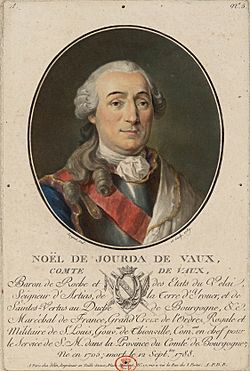Noël Jourda de Vaux facts for kids
Quick facts for kids
Noël Jourda
|
|
|---|---|

Noël Jourda, comte de Vaux
(Musée de la Révolution française) |
|
| Born | 12 March 1705 Le Puy-en-Velay |
| Died | 14 September 1788 (aged 83) Grenoble |
| Buried |
Paray (heart) / Retournac (body)
|
| Allegiance | |
| Service/ |
French Army |
| Years of service | 1723–1788 |
| Rank | Marshal of France |
| Battles/wars | |
| Awards | Knight of the Order of Saint Louis |
Noël Jourda de Vaux (born March 12, 1705, in Le Puy-en-Velay – died September 14, 1788, in Grenoble) was a French nobleman and a very important general. He was known as the Count of Vaux. He led the French army to take over Corsica in 1769. Later, in 1779, he was supposed to lead an invasion of Britain with Spanish help, but this plan was called off. He became a Marshal of France in 1783, which was the highest military rank in France at that time.
Contents
Life and Military Service
Noël Jourda de Vaux joined the French army on October 16, 1723. He started as an ensign, which is a low-ranking officer, in the Auvergne Infantry Regiment.
Early Campaigns and Battles
His first military experience was in Italy in 1733. He was a lieutenant and fought in battles like Parma and battle of Guastalla in 1734. He was wounded twice at Guastalla.
From 1738 to 1741, he served in Corsica. He was a captain and showed great bravery defending a place called Ghisoni. Because of his actions, he was made a knight of the Order of Saint Louis. He also became the commander of Corte in Corsica.
Fighting in Europe
After Corsica, Noël Jourda de Vaux fought in Germany. He became well-known during the Siege of Prague in 1742. On March 6, 1743, he was promoted to colonel of the Angoumois Regiment.
He continued to fight in many important battles and sieges. He was at the sieges of Menin and Ypres in 1744. In 1745, he fought bravely at the Battle of Fontenoy. He also helped in the sieges of Tournai, Oudenarde, Dendermonde, and Ath.
His actions during the siege of Brussels led to him becoming a brigadier on February 23, 1746. He then served at the Siege of Namur and the battle of Rocoux. He also took part in the Battle of Lauffeld in 1747, where he was wounded for the fifth time during the Siege of Bergen op Zoom. In 1748, he was captured but soon after was promoted to maréchal de camp, which is a rank similar to a major general. Later, he became a lieutenant general in 1759.
In 1760, he left Corsica to join the army in Germany. He fought in the Battle of Bergen and helped defend the area around Göttingen. In 1761, the king made him the governor of Thionville.
Conquest of Corsica and Later Years
In February 1769, Count de Vaux was given command of the French forces in Corsica. He arrived on the island in April and by August, he reported that "The whole of Corsica is submitted to the King." He was then made the governor general of Corsica.
In 1779, he was chosen to be the commander-in-chief of a large army. This army was planning to invade England with the help of the Spanish navy. Famous generals like Rochambeau and Lafayette were part of this force. However, the invasion plan was eventually cancelled.
In 1780, de Vaux became the commander-in-chief of the province of Burgundy. On June 13, 1783, he received the highest military honor: he was made a Marshal of France. His marshal's baton had the motto "Terror belli, Decus pacis" written on it, which means "Terror of war, Glory of peace."
In June 1788, Marshal de Vaux was sent to Grenoble to help calm a popular uprising. However, he became ill shortly after arriving and died on September 14, 1788, at the age of 83. He had fought in thirty sieges and five major battles, and he had been wounded five times. In his will, he asked for his heart to be buried in Paray and his body in the church at Retournac, where he was born.

